August 23, 1985
“Godzilla. I was hoping I’d never hear that name again.”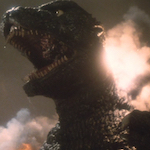
Near the conclusion of the Summer of 1985 – a movie season that attempted to bring back James Bond, the Vietnam War, pirates, Dorothy Gale, Clint Eastwood westerns, Mad Max, Walt Disney animation, the Griswolds, Dr. Frankenstein and two different types of Living Dead – America welcomed back a very large visitor from overseas. Godzilla had not had a movie since THE TERROR OF MECHAGODZILLA in 1975, so this is about the same as the gap between REVENGE OF THE SITH and THE FORCE AWAKENS, and it was a similar case of a younger generation being entrusted with reinventing and continuing an iconic series for modern audiences. Original producer/creator Tomoyuki Tanaka was still in charge, but director Koji Hashimoto (SAYONARA JUPITER) and writer Shuichi Nagahara (STRAY CAT ROCK: DELINQUENT GIRL BOSS) were both teenagers when the first film came out. (Hashimoto got his start as an assistant director on Toho movies in the ‘60s, including GODZILLA sequels).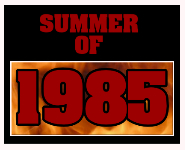
This one ignores all the previous sequels. There’s no Mothra, no Minya, no Monster Island, only the events of 1954’s GODZILLA: KING OF THE MONSTERS, so in that sense it’s less FORCE AWAKENS and more David Gordon Green’s HALLOWEEN. It was made for the 30th anniversary, so think about the films of 1990. In terms of time, if not cultural relevance, it’s like if this summer had a big new event sequel to TREMORS or DARKMAN, I guess? Or, to put it another way – GODZILLA 1985 is five years older today than the original GODZILLA was at the time. Shit.
Like many of Godzilla’s pictures, it starts with some dudes on a fishing boat getting knocked around by a terrible storm and seeing parts of a giant monster up close. Reporter Goro (Ken Tanaka, SANDAKAN NO. 8) locates the boat, and on board finds
 1) What looks like a mummified corpse
1) What looks like a mummified corpse
2) Some vomit or slime or something that he steps in
3) A “mutant sea louse” that scurries out and jumps him like a facehugger! I feel this is dismissed and forgotten pretty quick. Seems like someone should make sure there aren’t a whole bunch of those fuckers out there.
4) The lone survivor Kenny Okumura (Shin Takuma, SHOGUN), cowering in a closet. From him Goro gets the hot scoop that there was a giant monster.
But don’t start making room on the shelf for the Pulitzer quite yet. His editor (Kei Sato, HARAKIRI, KWAIDAN, SWORD OF DOOM, AZUMI) tells him he can’t publish the story, because the giant monster is Godzilla (Kenpachiro Satsuma, who had previously played Hedorah and Gigan and had been in G.I. SAMURAI), and it’s “a matter of journalistic responsibility” not to tell people Godzilla is out there, because they’ll panic and crash the stock market and shit.
Like Fletch would do, though, Goro keeps looking into Godzilla while on his next assignment interviewing a bio-physicist (Yosuke Natsuki, YOJIMBO) who he realizes went into this field because his parents were killed in Godzilla’s attack. Furthermore, the doctor’s assistant (Yasuko Sawaguchi, SPIRITED AWAY) is the sister of boat survivor Kenny, and doesn’t know he’s alive, so— well, you know, it’s pretty standard “human story in a Godzilla movie” material.
The American and 1985 part of it is that Godzilla destroys a Soviet nuclear sub, and “the Russkies” blame the Americans. So the Japanese Prime Minister (Keiju Kobayashi, SANJURO, A TAXING WOMAN) says, “Better call a press conference. Tell ‘em it’s Godzilla.”
(Goro: I… worked on this story for a year…and…he just…he tweeted it out.)
Japan meets with U.S. and Soviet envoys (introduced with little flags on the front of limos, obviously) and refuses their request for permission to nuke Godzilla. The various parties prepare different plans. The Japanese scenes are all dubbed into English, but there are scenes at the Pentagon shot in English. When newspaper reporter Steve Martin (Raymond Burr, reprising his 1954 role between AIRPLANE II: THE SEQUEL and PERRY MASON RETURNS) somehow just walks into the room, the general (Warren J. Kemmerling, HIT!, 92 IN THE SHADE, CLOSE ENCOUNTERS OF THE THIRD KIND) says “Thank God you’re here!” because he’s the only American who personally witnessed the original 1954 Godzilla attack. When they’re trying to figure out how to repeat what was done to stop Godzilla last time, Mr. Martin (obviously they avoid using his full name this time around) says, “And, just for the record, 30 years ago they never found any corpse.” I thought that was funny because, yeah, no shit – Godzilla is still alive. Isn’t that what we’re talking about?
The Americans have lots of obstacles, including that the hotline to Moscow is “down for repairs” and that they have to put up with a comic relief major (Travis Swords, PINK CADILLAC, IF LOOKS COULD KILL) who says stupid stuff like, “My God. That’s, uh, quite an urban renewal project they’ve got over there!” and “Wonder Lizard is down for the count.”
That guy sucks, but I kind of like the comical interludes about a homeless guy (Tesuya Takeda, THE YELLOW HANDKERCHIEF) who, during Godzilla’s attack on Tokyo, breaks into a fancy restaurant to dine and talk to himself, getting in some OMEGA MAN type fun during the evacuation.
The various parties have different interpretations of Godzilla (he’s like a nuclear bomb, he’s like a hurrican or tornado, “he’s a product of civilization”) and come up with different plans (send in the Delta Force with heatseeking missiles, have a dying guy push a button that launches a nuclear missile 50 times as powerful as Hiroshima from space “violating the U.N. space treaty,” send in a space ship thing called Super-X to fire cadmium missiles). But of course our scientist/journalist civilian team figures out the real secret: “ultrasonic images” show that Godzilla’s brain is similar to a bird’s, and also he stopped one of his attacks right after a cool flock of animated seagulls flew over, so that means they can create simulated bird calls to lure him into a volcano and trigger a “controlled eruption” with bombs.
Although Godzilla is not seen until almost 25 minutes into the movie, once he does show up he’s pretty consistently around after that, and there’s been a noticeable improvement in kaiju technology since ’75. Yes, Godzilla is still a rubber suit, as tradition dictates. But it’s a more detailed sculpt, he has a cool articulated tail that can move like a snake, and his mouth and brow have animatronic movements that make him more expressive than before. In one part he gets whacked and you see drool come out of his mouth before he stumbles sideways into a building. And there’s an amazing shot where he rises up from being completely submerged in the water – that one looks like a drowning hazard!
I enjoy the goofiness of his bulbous eyes, with veins noticeable in closeup. And they get pretty elaborate with the jets shooting missiles at him, water splashing around him, explosions happening on and around him, smoke coming off him.


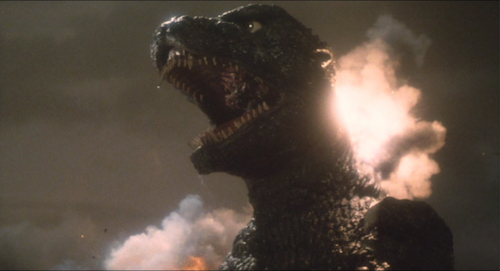
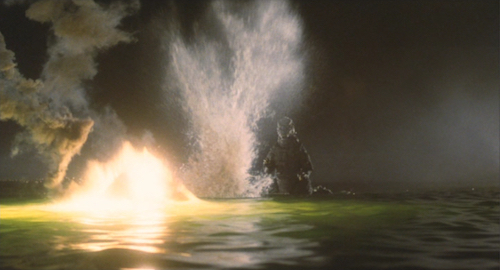
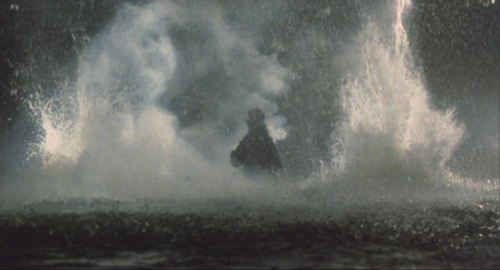
I like the part where he picks up a nuclear reactor and his dorsal spikes light up as he absorbs its power. This is a good use of advances in optical FX and makes for a more godlike Godzilla.
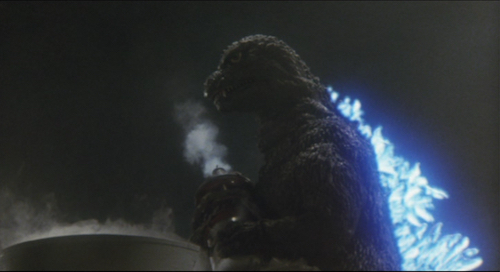
There’s also extra detail in the pieces of buildings that break off, and things like mirrored windows on skyscrapers where you can see his reflection. This had to be done smaller than on the old movies, because they decided Godzilla was 30 meters taller to compete with modern skyscrapers. To someone who enjoys this type of movie (because I’m one of ‘em) this movie is a major breakthrough, a much more modern type of giant monster movie than ever seen before. But compared to Hollywood FX-driven movies like, say, RETURN TO OZ (not that many people were watching that), of course it’s technologically primitive. That combined with the dubbing seems to have allowed for many Americans to treat it as a ha ha, can you believe those silly Godzilla movies, the words don’t even fit the mouths type situation. 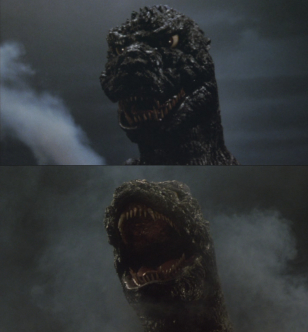 Leave it to the Stupid Fucking Razzies (SFR) to nominate “the new computerized Godzilla” for “Worst New Star.” That presumably refers to the 16-foot high hydraulically-powered “Cybot” Godzilla used in closeups where he roars and has more sophisticated expressions than in previous movies. Obviously as a person who isn’t molded from wet garbage I respect the Cybot and would like to see him take a giant hydraulic dump on every member of the Stupid Fucking Razzies Nominating Committee. (They also nominated Raymond Burr for “Worst Supporting Actor,” which I’m more neutral on.)
Leave it to the Stupid Fucking Razzies (SFR) to nominate “the new computerized Godzilla” for “Worst New Star.” That presumably refers to the 16-foot high hydraulically-powered “Cybot” Godzilla used in closeups where he roars and has more sophisticated expressions than in previous movies. Obviously as a person who isn’t molded from wet garbage I respect the Cybot and would like to see him take a giant hydraulic dump on every member of the Stupid Fucking Razzies Nominating Committee. (They also nominated Raymond Burr for “Worst Supporting Actor,” which I’m more neutral on.)
But the attitude extends to critics who usually knew better. I don’t mind that Roger Ebert gave it one star, but he claims it’s trying to be a “good bad movie” and seems to think we all agree the original is some kind of laughable trash that everybody enjoys ironically:
“The filmmakers must have known that the original Godzilla from 1956 had many loyal fans all over the world who treasured the absurd dialogue, the bad lip-synching, the unbelievable special effects, the phony profundity. So they have deliberately gone after the same inept feeling in GODZILLA 1985.”
Of course he’s wrong – the American producers did want to make it into a comedy, but Burr insisted he would only do it if it was respectful, as it’s clearly intended to be.
(More related data to consider: Ebert gave the 1998 GODZILLA a half star higher rating.)
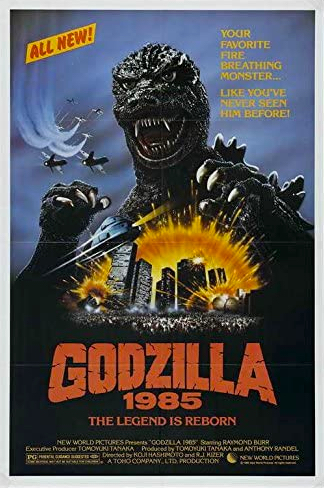
That Ebert even reviewed it shows that GODZILLA 1985 was a bigger release than WARRIORS OF THE WIND earlier in the summer, but it’s similar in that it was a Japanese film that had already been released in Japan in 1984, now dubbed and re-edited by an American exploitation company, in this case Roger Corman’s New World Pictures. They were, of course, following the tradition of the first film’s American release with added Raymond Burr scenes. The Japanese version, THE RETURN OF GODZILLA, is about 16 minutes longer, despite having none of the English language scenes. Producer Tanaka had been trying to resurrect the series for several years, and tried to get director Ishiro Honda and composer Akira Ifukube to return (they declined to, respectively, assist Kurosawa on KAGEMUSHA and RAN, and teach at Tokyo College of Music). Composer Reijiro Koroku hasn’t done any other movies I’ve heard of, but I think he did a good job creating a really bombastic kaiju score and a beautiful, sad theme for Godzilla’s plummet into the volcano.
(A little bit of the music reminded me of HELLRAISER, which turns out to be because the American version uses some pieces of the score for DEF-CON 4 by Christopher Young.)
Due to rights disputes, only the original Japanese version has come out on disc, so for historical accuracy I watched the American release from VHS before using the DVD for screengrabs. Normally I prefer subtitles, and I’m sure the original cut is the superior version, but the main reason I’ve enjoyed this movie over the years was added for Americans, and that’s Raymond Burr’s narration at the end. Both versions end with exactly the bullshit I love: as the humans finally succeed in killing Godzilla they don’t, like… applaud in the control room. They look on with an understanding that this fucking sucks that they had to do this. Solemnity, tears, violins. But only the American one has reporter Steve Martin’s voiceover about how Mother Nature “occasionally throws up the terrible offspring of our pride and carelessness to remind us of how puny we really are in the face of a tornado, an earthquake or a Godzilla,” calls him “that strangely innocent and tragic monster,” and concludes that “Whether he returns or not or is never again seen by human eyes, the things he has taught us remain.”
(Cut to credits. Beautiful.)
New World hired Tony Randel, who had worked on visual FX for BATTLE BEYOND THE STARS, ESCAPE FROM NEW YORK and FORBIDDEN WORLD, to produce the American version. He got his GRUNT! THE WRESTLING MOVIE co-writer Lisa Tomei to script the dialogue for the English dub, and an uncredited Straw Weisman (FIGHT FOR YOUR LIFE, RED SCORPION 2) to write the new scenes. Those were directed by R.J. Kizer, an editor for Corman, most notably for BATTLE BEYOND THE STARS and GALAXY OF TERROR. He also had a little experience in bastardizing Japanese films for the U.S., as re-editor of GALAXY EXPRESS 999.
The approximately 10 minutes of new footage was shot in three days, but Burr would only work one 8-hour day, with a teleprompter. Footage from THE PHILADELPHIA EXPERIMENT was used for the war room.
IMDb also lists MONSTER SQUAD director Fred Dekker as a writer, but not for anything to do with the new scenes – apparently it’s because the Soviet submarine and Super-X ideas come from his script for GODZILLA KING OF THE MONSTERS 3D, the unproduced American Godzilla that would’ve been directed by Steve Miner with a stop motion Godzilla. Man, I wish that movie had happened! (The Best Movies Never Made podcast did an episode about it if you’re interested.)
I got a laugh from the prominent placement of a Dr. Pepper vending machine in the first English language scene. A pretty long conversation happens with it in the background, and you can’t keep your eyes off of it, like Pee-wee in his cameo as the bellboy.
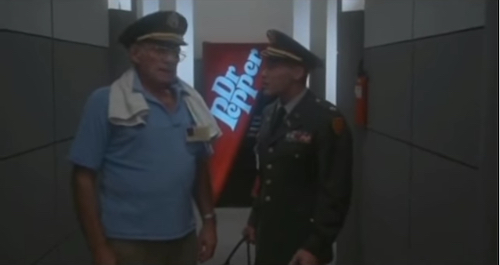
Later, in the climactic scene where Godzilla heads for the volcano on Yoshima Island, the doofus major is drinking a can of Dr. Pepper. It makes logical sense, because it has been strongly established that Dr. Pepper is available right out there in the hallway. That’s just tight storytelling. But according to The Official Godzilla Compendium by J.D. Lees and Marc Cerasini, “The American beverage bottler Dr Pepper agreed to sponsor the opening of the film in the United States, and even hired Godzilla to do a series of clever, sophisticated commercials.”
Fortunately those are on Youtube, so we can see that they’re impressive! I pictured recycled footage from the movie, but its a whole separate thing playing off the old black and white classic, with a redesigned Godzilla, less realistic but more stylized, with lightup eyes and outlines on his dorsal plates. And there’s another monster character, too.
The VHS tape and, according to some sources the theatrical release of GODZILLA 1985 opened with a short subject, director Marv Newland’s 1969 independent film BAMBI MEETS GODZILLA. It’s less than two minutes of one dumb joke and I will tell you, at least for a young person in the 1980s this thing was legendary. It’s so dumb and it’s kind of amazing to watch how simple and hand made and crappy it is and know that there are more modern equivalents on Youtube than any human being could or should watch in a lifetime, but because back then it took dedication and money to film and distribute it actually meant something.
Also Godzilla’s toenail design is better in the short than in the feature, in my opinion.
The original version had been “a reasonable success” in Japan, and (though it took five years for a followup) it kicked off the “Heisei era” Godzilla series that pitted Godzilla against Biollante, King Ghidorah, Mothra, Mechagodzilla, SpaceGodzilla and Destoroyah before another reboot in 1999. As an American release it was a smaller deal. Box Office Mojo says it opened in 17th place, below THE BRIDE in its disastrous second week. But to be fair it was only on 235 screens, and its per-screen average of $2,168 was higher than almost everything below the top 5 (the exception was COCOON, which only beat it by $22). It only made about $4 million, but the Godzilla fan wiki confirms that was profitable for them even before video (though the expense for prints and advertising was $2.5 million!). I bet it made them more money than THE STUFF.
I can only speculate what it was like to see GODZILLA 1985 on a big screen in the actual year of 1985. But in this 35 years later home video re-enactment of the season it fulfilled the tradition of lowbrow movies dumped off in August because normal people think they’re crap but they are still able to bring people like me some joy. There’s more to summer than blockbusters. Thank you for your service, New Computerized Godzilla.
NOTES:
Summer of 1985 connections:
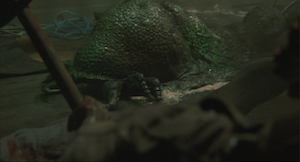 The mutant sea louse reminds me of a bug that would be in fellow 1984 Japanese movie repackaged in a drastically Americanized version in the Summer of 1985, WARRIORS OF THE WIND.
The mutant sea louse reminds me of a bug that would be in fellow 1984 Japanese movie repackaged in a drastically Americanized version in the Summer of 1985, WARRIORS OF THE WIND.
Like GOTCHA, GYMKATA, THE STUFF, VOLUNTEERS and arguably WEIRD SCIENCE, the Cold War is a major story component. And it was juiced up for the American version – originally the Soviet captain died trying to stop the launch of the missile, but they changed it to him launching it as a dying act. If it was supposed to be propaganda it failed, because the fact that these Americans stand around acting important while being mostly irrelevant to the plot comes across as kind of satirical.
And of course just like John Candy had a cameo in FOLLOW THAT BIRD and then starred in SUMMER RENTAL, Godzilla had a cameo in PEE-WEE’S BIG ADVENTURE followed by this.
Pop culture/time capsule stuff:
Steve Martin’s grandson is seen playing with a robotic dinosaur toy that I believe is a Zoid. I saw something I thought was a GHOSTBUSTERS billboard on a model building when I watched it on tape, but I couldn’t find it on the DVD.
Legacy:
Kenpachiro Satsuma continued to play Godzilla in eight more films. He also played the title monster in PULGASARI (infamous because it was one of the movies that director Shin Sang-ok had to make after Kim Jong-il had him kidnapped by North Korean intelligence).
It was the final GODZILLA movie for veteran FX director Teruyoshi Nakano, but one of his assistants, Shinji Higuchi, later did the FX for the ‘90s GAMERA trilogy and co-directed SHIN GODZILLA.
U.S. version producer Tony Randel went on to direct HELLBOUND: HELLRAISER II, TICKS and FIST OF THE NORTH STAR.
American director R.J. Kizer later directed HELL COMES TO FROGTOWN and DEATH RING, but he’s spent most of his career working in the sound department, most recently as dialogue editor on BAD BOYS FOR LIFE.
Dr. Pepper continues to be delicious to this day.


























August 31st, 2020 at 11:36 am
This is the content I come here for and live for…
I’ve always liked this one. Even the bastardized US version. I mean, yeah, SHIN GODZILLA would late do what this one does but way better, but I still think it’s ‘outsiders’ look at the Cold War gives it merit. And I’ll always love the stories that New World wanted to do a parody only to be shocked to learn Raymond Burr took this bullshit seriously. I’ll always tear up with his monologue that he supposedly wrote himself at the end.
Not mentioned in your great write-up, the rare music video made for the US Version which is a song about learning to love Dr Pepper!
Godzilla 1985 - I Was Afraid to Love You Music Video
The notorious Godzilla 1985 "I Was Afraid to Love You" music video produced by Dr. Pepper (the film's US product sponsors) that only aired twice on MTV befor...